Physical Address
304 North Cardinal St.
Dorchester Center, MA 02124
The follicle—the functional unit of the ovary—consists of an oocyte in the late prophase of the first meiotic division surrounded by granulosa cells enclosed by a basement membrane. Later, during follicle growth, it will become surrounded by theca cells.
Human gonads of both sexes are established at week 4 post conception (pc) and are intimately connected to the mesonephros throughout early differentiation. The gonads are populated by somatic cells deriving from the mesonephros, as well as cells from the coelomicepithelium. , The primordial germ cells (PGCs) are specified far from the gonad in embryonic epiblast. , The PGCs migrate initially to the yolk sac wall, then through the hindgut towards the gonads in week 4 to 5 pc mediated by chemotactic signals, active movement, and nerve fiber guidance, and populate the gonads at the ventrocranial aspect of the mesonephros in week 6. ,
Three major events are prerequisites for the development of a functional ovary: (1) initiation of germ cell meiosis, (2) formation of follicles, and (3) differentiation of steroid-producing cells. In humans, as in many other mammalian species, these events begin during embryonic life, at a time when germ cells and somatic cells have populated the ovarian anlage.
Meiosis and follicle formation are interrelated processes, the first being the prerequisite for the second, which secures survival of the oocyte. The primordial follicles constitute the ovarian reserve, providing a steady number of growing follicles some of which will develop to antral and potentially ovulatory stages in adult life. The female reproductive life span is determined by the number of resting primordial follicles. The steroidogenic theca cells enclose the growing follicle and provide the androgen substrate, which is converted to estrogen by the granulosa cells.
In most vertebrate classes, gonadal differentiation is the result of the genetic sex. In mammals, the gonads arise from thickenings of the coelomic epithelium and are initially bipotential, having the capacity to develop as testes or ovary. The fate of the indifferent gonad is dependent on the presence or absence of a Y chromosome: the gonad becomes a testis when a Y chromosome is present, and an ovary develops if this chromosome is absent, irrespective of additional sex chromosomes. In 1990, the testes determining factor was identified as a single gene, named Sex-Determining Region Y ( SRY ), , the expression of which is sufficient to direct the formation of testes in chromosomally female (XX) mice. SRY initiates a cascade of gene networks through the direct regulation of Sox9 expression initiating differentiation of the supporting cells (i.e., Sertoli and Leydig cells), vasculature formation, and testis cord development. In the human embryonic testis SRY is activated in embryonic week 6 initiating the sex differentiation. In the female embryo, the absence of SRY initiates alternative genetic cascades, including female sex-determining genes RSPO1, Wnt4/β-catenin , Foxl2 , Follistatin (Fst), and Gata4 leading to formation of the ovaries and including fallopian tubes, uterus, and upper part of the vagina. ,
In humans, PGCs arise from the cells of the embryonic epiblast, under the inductive action of Wnt3 and bone morphogenetic proteins (BMPs) 2, 4, and 8b. These signals induce expression of SOX17 and PRDM1 (BLIMP1) in a localized subset of epiblast cells, directing them to adopt a PGC fate and upregulate PGC-specific markers such as DPPA3 (STELLA). Significant species-specific differences exist between PGC specification in humans (and most mammals) and rodent models: PGC specification in mice does not require SOX17, while PRDM14 is an essential regulator of the process in mice but appears to be dispensable in humans.
Proliferating PGCs migrate first to the extraembryonic mesoderm or dorsal yolk sac wall, then along the hindgut, through the dorsal mesentery towards their final destination at the gonadal ridge. , The PGCs migrate along autonomic nerves to the gonad, guided by chemotactic mediators such as the c-kit receptor and its ligand. PGC migration is completed around the ninth week of fetal life. , Simultaneously, invading mesonephric cells accumulate in the central medullary region of the ovary, and form the intraovarian rete ( Fig. 147.1 ). The proliferating germ cells (now termed oogonia) with intermingled somatic cells (precursors of the granulosa- and theca-cell populations) become separated from areas of somatic cells by a basement membrane. This prevents cell intermingling although the basement membrane-enclosed regions are open at the periphery of the ovary. Within these germ cell cords the germ cells divide with incomplete cytokinesis mediated by germ cell-specific factors including Tex14 and DAZL, giving rise to clusters of germ cells linked with intercellular bridges termed germ cell nests. It appears that mouse germ cells receive organelles and cytoplasm from the surrounding nest cells to become oocytes, whereas the donor germ cells die. The formation of intercellular bridges between germ cells is, however, not essential for the oocyte competence, since Tex14- or DAZL- deficient mice develop functional oocytes in the absence of bridge formation (albeit in reduced numbers). , Oogonia continue to express pluripotency markers such as OCT4 and LIN28 during proliferation in the primitive ovary, but these factors are lost shortly before or at the initiation of meiosis ( Fig. 147.2 ).
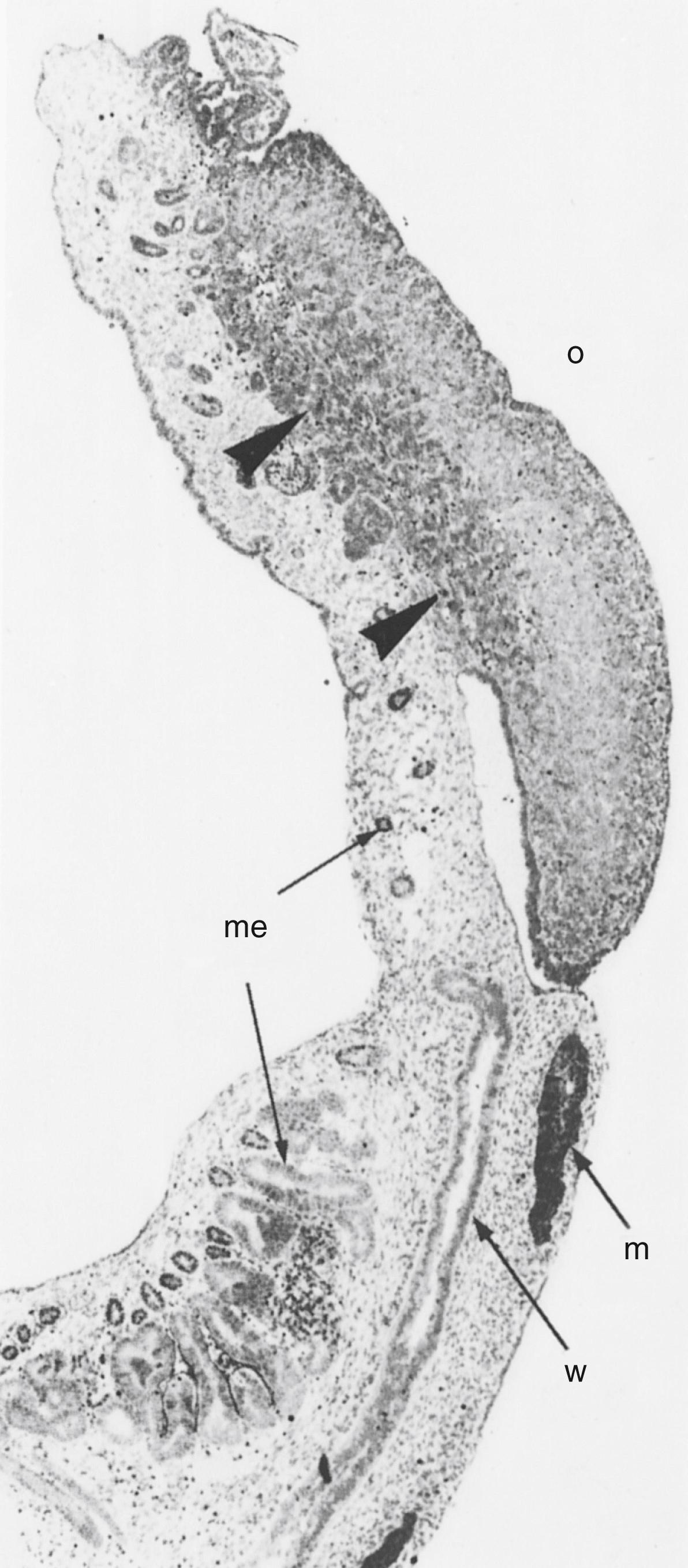
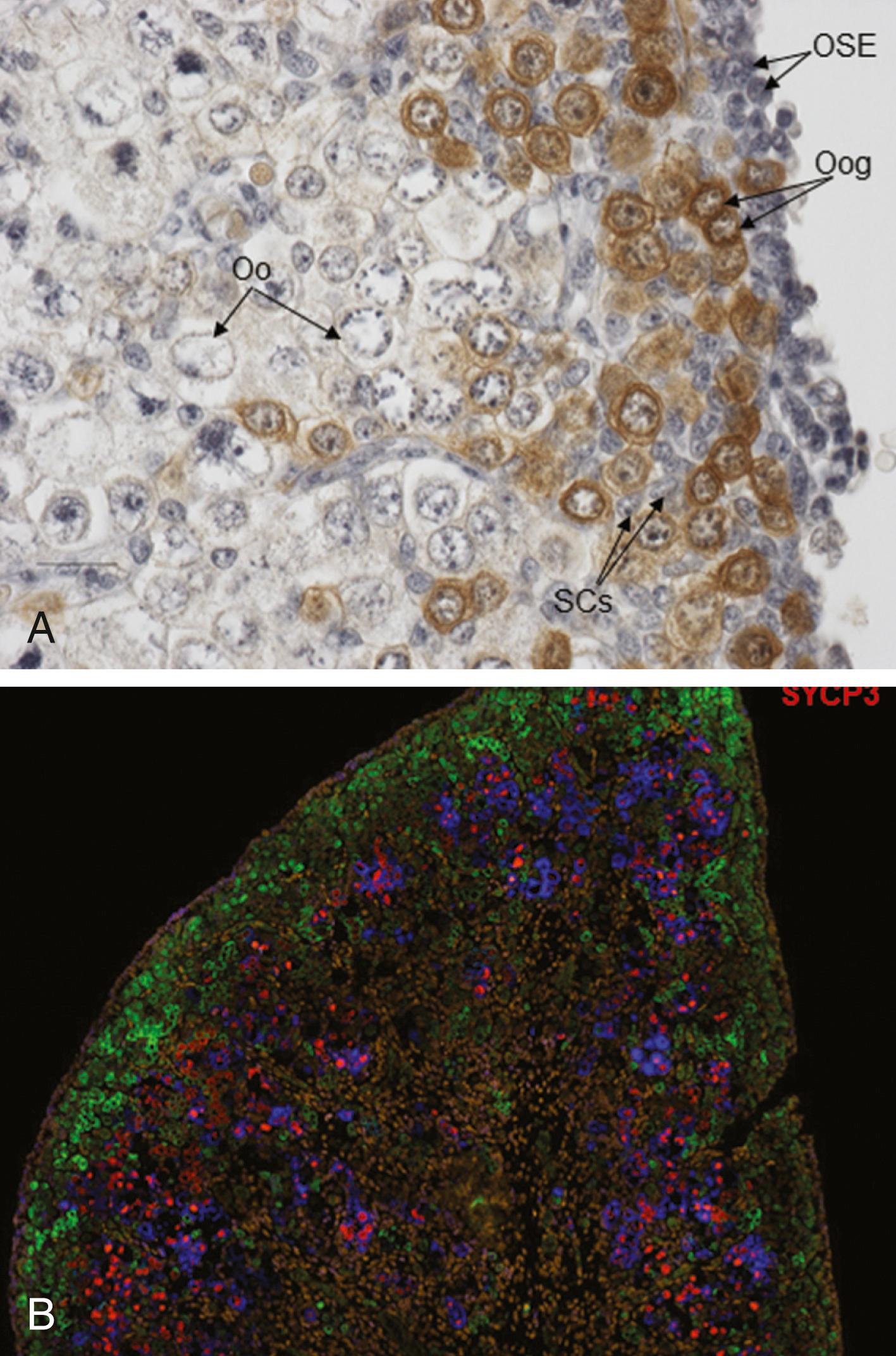
By morphologic criteria, the ovary is usually recognizable at a later stage of gonadal differentiation than the testis. The first indications that the indifferent gonad is becoming a testis are the formation of the testicular cords enclosing the germ cells and the rounding up of the organ. In the human testis, these events take place at the sixth week of fetal life.
Cords enclosing the germ cells are, however, also seen at early stages of ovarian differentiation in some mammalian species (e.g., the pig and the sheep). In other species (e.g., the mouse and the hamster), the germ cells are not confined to cords and the germ cells are more evenly distributed throughout the ovary. , These different patterns of germ cell location within the ovary are closely related to the onset of meiosis—in all females the cords disappear when meiosis starts. In species in which germ cell cords are formed, meiosis is delayed until the cords dissolve, whereas in species without cord formation, meiosis proceeds immediately. During the delay period, transitory ovarian steroidogenesis takes place (see later). This is analogous to early testicular differentiation, in which steroidogenesis begins immediately after testicular cords are formed. , It has been proposed that enclosure of germ cells into specific germ cell compartments, either as temporarily formed cords or as follicles, is a prerequisite for the start of steroid production in the developing gonads.
Morphologically and functionally, the human fetal ovary represents an intermediate type between immediate and delayed meiosis. Although germ cells appear in clusters during fetal life, well-defined cords are not formed ( Figs. 147.3 and 147.4 ). Nonetheless, the delay period lasts for a relatively long time, from the onset of sex differentiation at approximately the sixth week of fetal life until the ninth week, when meiosis starts. , Although the aromatizing enzyme system is present by the sixth week of fetal life, few or no steroids are produced by human ovaries during the delay period. Interstitial cells with ultrastructural resemblance to steroid-producing cells have been recognized from the 13th week of fetal life ( Fig. 147.5 ).
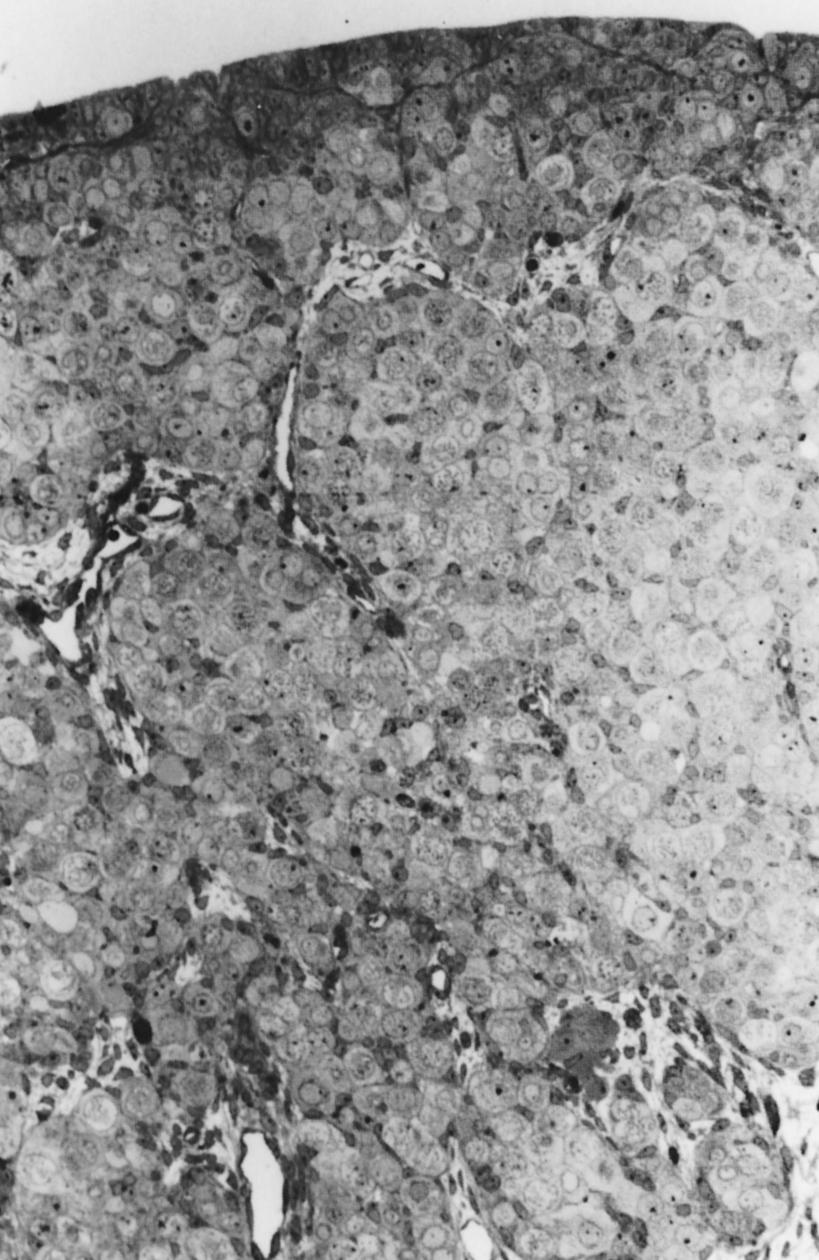
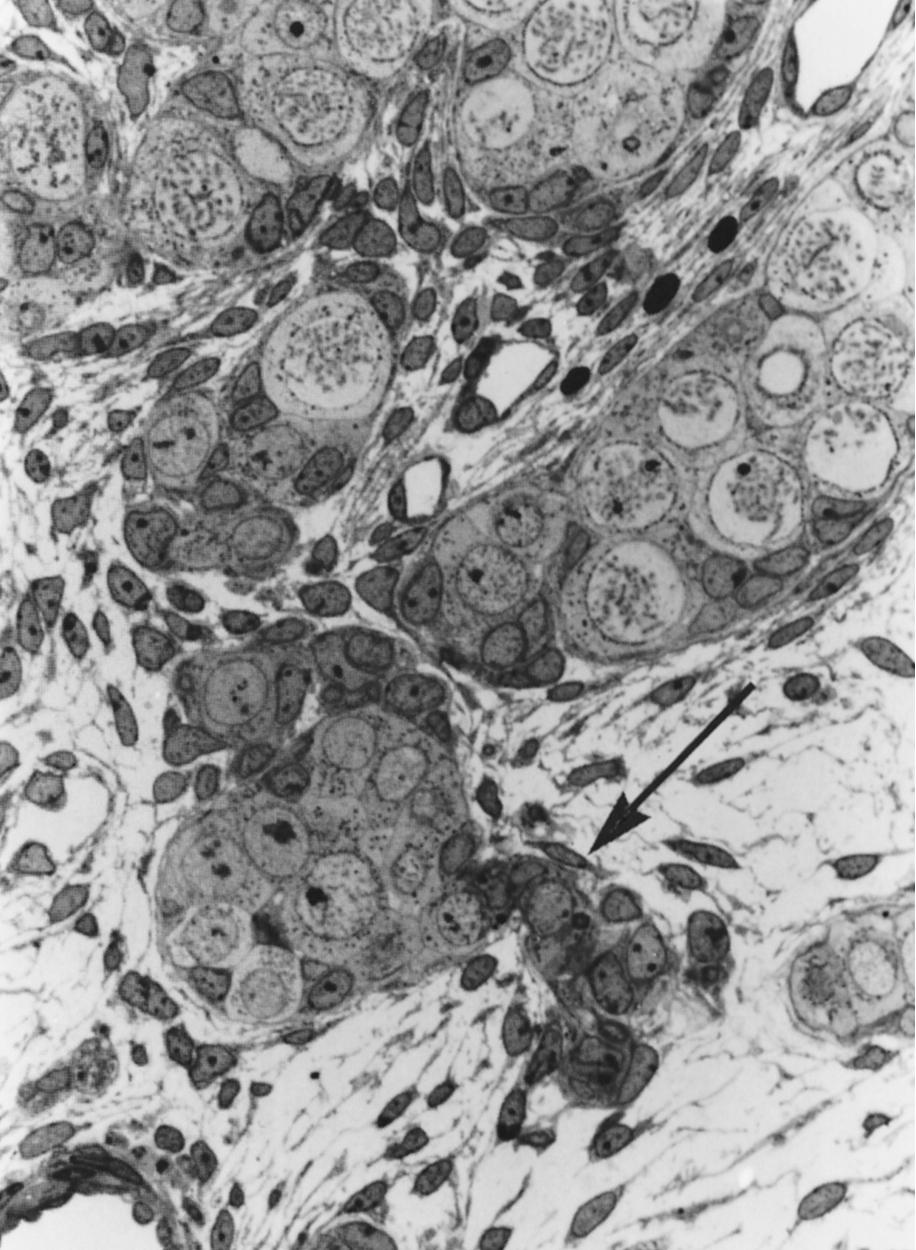
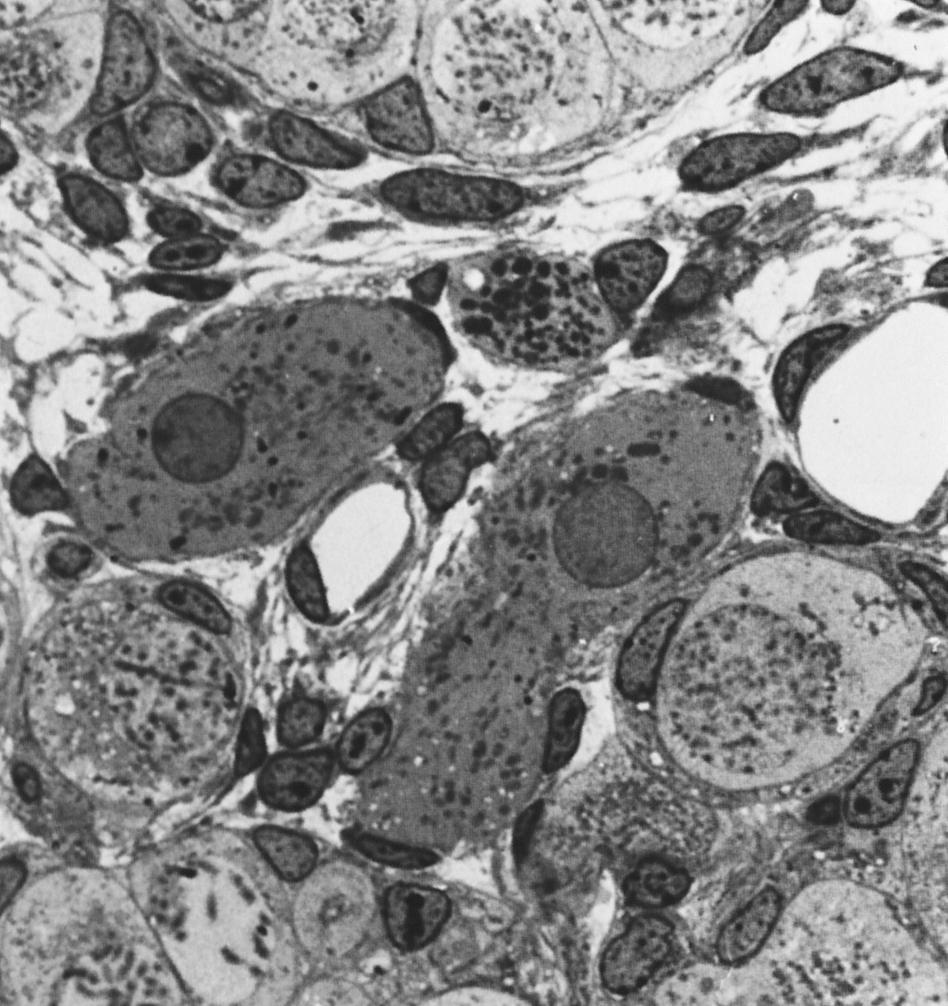
The origin of the somatic cell population of the cortex is uncertain, and different theories have been proposed. Generally, the following sources for their origin have been suggested: the surface epithelium, , the mesonephros, or a combination of the two. , A 2018 review suggests that the granulosa cells derive from the somatic progenitor cells located in the gonadal ridge, whereas theca cells derive from at least two progenitor populations: the majority deriving from the gonadal ridge and a smaller population deriving from the mesonephros. Analysis of bovine ovarian development has identified a putative cell termed the gonadal ridge epithelial-like (GREL) cell, which derived from the surface epithelium of the mesonephros and penetrate, intermingled with oogonia, into the ovary giving rise to the granulosa cells population.
Become a Clinical Tree membership for Full access and enjoy Unlimited articles
If you are a member. Log in here